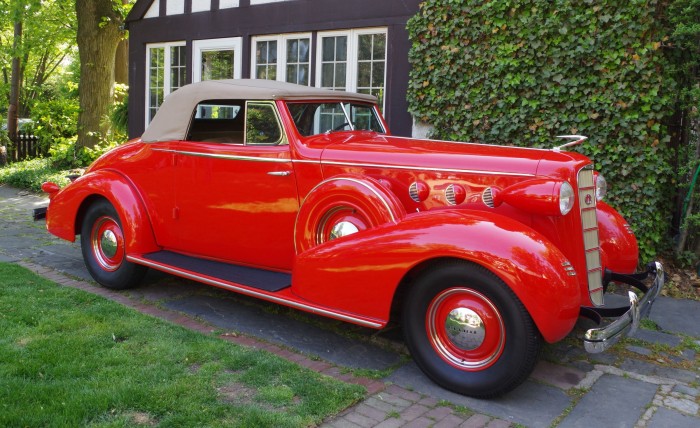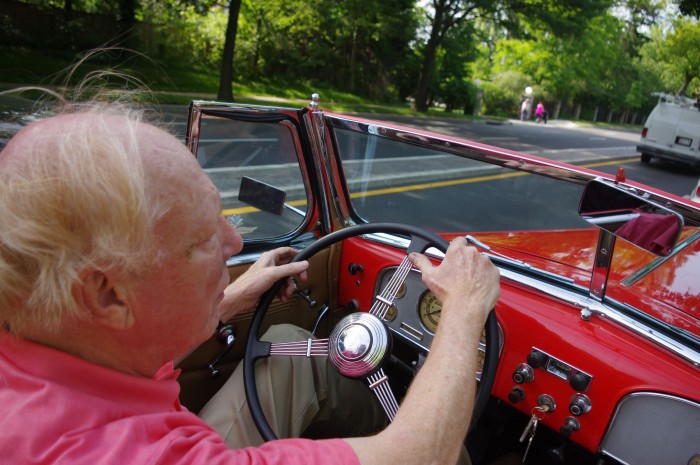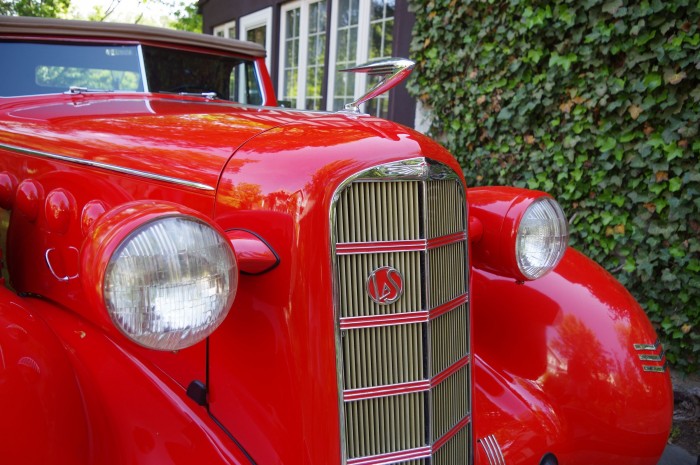Prewar Motoring – Driving a 1935 La Salle through D.C. traffic
Posted on May 4, 2019 in Featured | 2 comments

Randy Denchfield’s 1935 La Salle Convertible Coupe.
This past May, while driving up to New York City to visit my family, I made a detour to the Washington D.C. area to photograph this lovely 1935 La Salle Convertible Coupe for my forthcoming Cadillac book. Owned by Cadillac collector Randy Denchfield, it’s one of two ’35 La Salles in his collection, and without question one of the finest in the country.
After our photo shoot commenced, Randy took me for a nice drive in and around his pleasant Chevy Chase neighborhood. With the top down, we were enjoying the spring sunshine and reveling in the beauty of the La Salle’s distinctive styling. Then Randy pulled over and told me to take the wheel and experience the La Salle motoring experience firsthand.

Randy behind the wheel of his La Salle.
Driving a prewar automobile is an all-hands-on-deck encounter. With only three speeds on the manual gearbox, a non-synchromesh first gear, low-ratio worm-and-roller steering and manual four-wheel drum brakes, you drive the car – it doesn’t drive you. You have to be 100 percent alert at all times as to what the car is doing – or not doing – and plan ahead any braking and steering movements. Yes, steering too, because turning the big wheel doesn’t generate much response, and when it does begin to turn the front wheels, it all happens in very slow motion. This is why it’s imperative to think ahead, and plan things out before reaching that corner.

Under the Art Deco-adorned hood lies a straight-eight flathead engine that produces 105 horsepower, which at times is barely enough to get the 3,510-pound beauty up to speed – especially if the street has a slight incline. But it gets there, and it gets you there in style, with everyone who passes by waving and giving you the thumbs up.
That’s the beauty of prewar automobiles – they force you to drive slow and to take in the scenery as you pass through it. It’s a rudimentary driving experience that really is enjoyable, if, that is, you’re not in any sort of hurry. And when you factor in the noise from the gears and the sounds of the flathead’s mechanical clatter, it becomes an all-encompassing primeval experience that for serious car enthusiasts simply can’t be beat. Tiring, yes, but oh, what fun.





Nice car, and good words of advice, you don’t drive an old car like a new Mustang. When new, these cars were about $1300 (or $23,079 in today’s money, the hood ornament alone was $20 or $350 today), when you could buy a new Ford for half that. Color is a little loud for 1935, as I can’t find a color like that for LaSalle’s in 1935. Some sites say this was an Oldsmobile motor. I can only imagine, the family gathering was 2nd fiddle to driving this beauty.
you may be right. I believe this 1935 should have (if originally in red hues) a maroon(ish) hue. I believe there were three maroon hues.
Nonetheless, the “fire-engine” red of this beauty serves as an additional safety feature: which might yet save her for years to come.
My opinion has always been: “There are a select few cars and marques which should be no longer driven regularly; BUT, as a rule, a car is meant to be driven. A boat in harbor is safer than a boat at sea. BUT SAFE IS NOT WHAT BOATS WERE BUILT FOR!” Same with cars (except the sea part, of course: substitute “at port” and “at sea” with “in a museum” and “on the roads”.)